If anyone reads the medieval history of the Catalan region, the name Wilfrid the Hairy always comes to the fore. His main achievement as Count of Cerdanya, Urgell, Girona, Ausona, Besalú, and Barcelona was the unification and repopulation of his devastated lands and the creation of the state of Catalonia. As for his name, the Gesta comitum barcinonensium only states that he “… was hairy in places not normally so in men…” I have spent far more time than it deserves trying to parse this description.
One of Wilfrid’s descendents as Count of Cerdanya, Oliba of Besalù, was also the abbot of the monastery of Cuxa. Founded in 878 after a flood wiped out a nearby monastery in the gorge of the river Têt, the Abbaye Saint Michel-de-Cuxa rapidly gained importance in the medieval church. By the time Oliba came along in the 11th century, his abbey church (originally built 956-974) was in need of expansion. Oliba built an ambulatory around the choir, the crypt with a chapel, and a pair of bell-towers.
The years have been hard on Saint Michel-de-Cuxa, as they have been for so many other churches. There are only two remaining elements from Abbot Oliba’s 11th century renovations. The first is the masterful clocher, a four level castellated bell tower. The first two floors feature Lombard bands and narrow windows. Oliba’s northern bell tower collapsed in a storm in 1839.
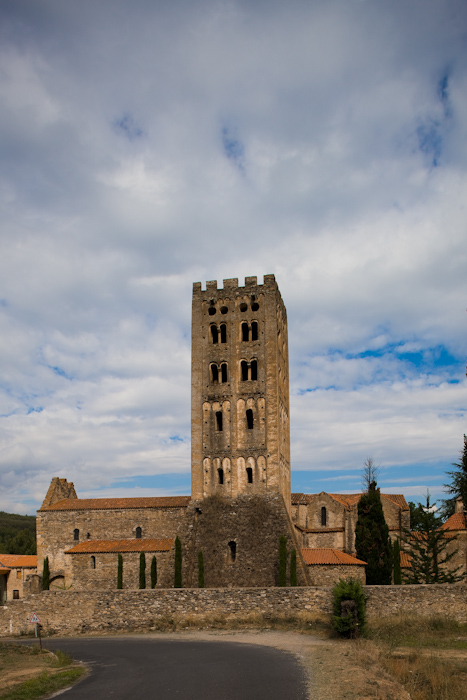
The second remaining element of Oliba’s expansion is the underground crypt which is essentially a series of passageways connecting different chapels.

The crypt’s Pessebre or Nativity rotunda is a spectacular circular barrel-vaulted chamber supported by a central pier. In this shot we can see the chapel of the Virgin of the Nativity just beyond the pier.
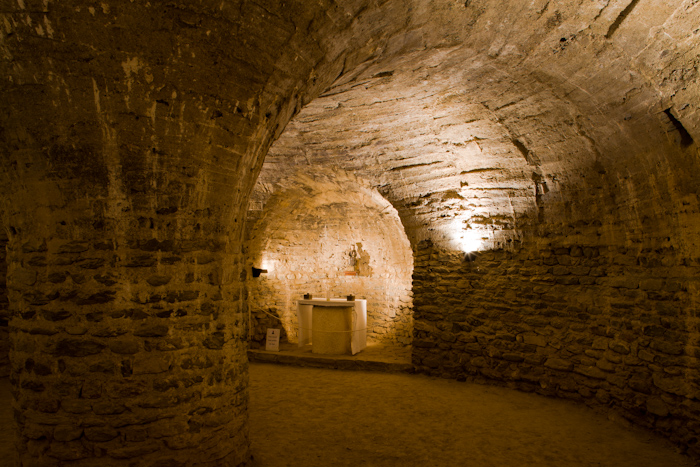
While Oliba’s 11th century additions to the interior of the church are gone, the original Carolingian nave remains largely intact. The simple structure has much in common with the interior of the Église Saint Etienne de Vignory, another pre-Romanesque survivor in France. The arcades are flat walls with arches that carry up to the wooden roof. The windows shown on the south side are an anomaly, I believe, probably constructed later in the church’s history, especially since they are only on the one side.

The church has the two conventional side aisles, but notice the remarkable difference for its Romanesque brethren. The transverse arches are not round or ogive, but horseshoe (or keyhole) in shape. This is a reflection of the very early origin of the church since this shape shows Moorish and Visigothic influence. Also notice that the doorway in the center of the shot is not covered with an arch, but with a curved lintel.

Oliba’s apse with its ambulatory is long gone. We are left with a simple raised apse with a flat chevet covered with a groin vault.

Somewhere around the year 1130 a marble cloister was built under the direction of Abbot Gregory. The cloister is the largest in Pyrénées, despite half of it residing in the United States at the Cloisters Museum in New York. In situ, here at Codalet, we see the extent of this massive quadrangle. The half in New York has been reconfigured to make a square that is much smaller than originally intended, one quarter of the area of the one we see here.

The cloister walkways are separated from the garth – the central enclosure – by arcades formed by narrow pillars, topped with capitals. The base of the arcades make a fine place to sit and were surely appreciated by the monks during the course of their studies and devotions.
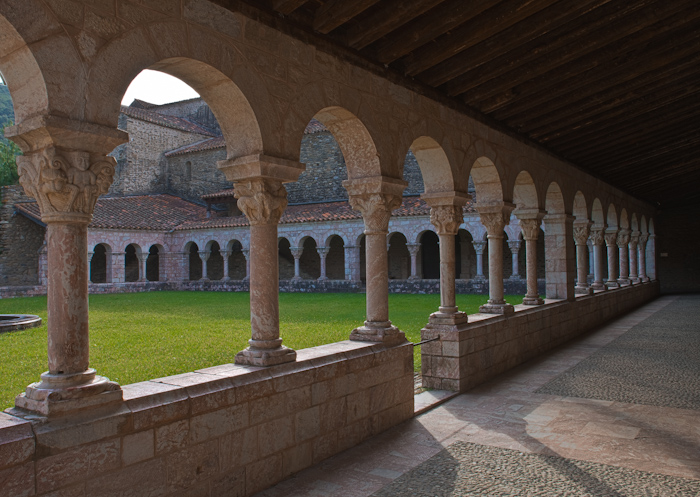
In the cloister of Saint-Michel de Cuxa, we see the slender columns of pink Conflent marble supporting superb capitals. The man-made decoration was often supplemented in the garth with cloister gardens featuring herbs and flowers.
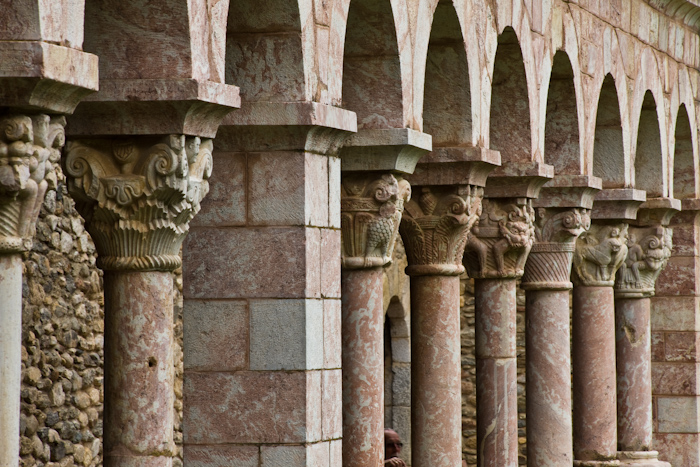
The ornamentation of the capitals features foliage, animals and historiated capitals. What is unique about Saint Michel-de-Cuxa, however, is that these are not all stories from the Bible or the life of Christ; the preferred themes include delicately chiseled fantastic bestiary and plant motifs. One capital even features Gilgamesh, a character from Sumerian mythology.

In the chapel of the north transept is a charming 13th century polychrome Vierge romane. The statue has suffered a great deal of deterioration over the years, but we can still see why it has been revered for so long. The right hand of the Virgin, which is outstretched, would have held a flower or a scepter at one time. PJ and I both love the elongated fingers that are characteristic of these statues.
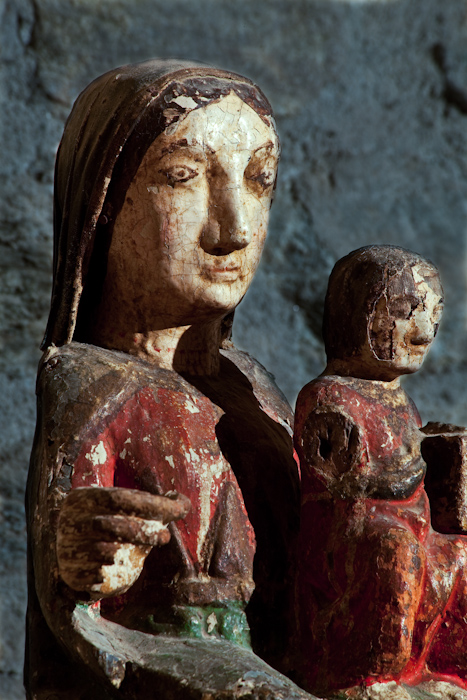
As for Abbot Oliba himself? He served God and Mammon simultaneously as the Abbot of Saint Michel-de-Cuxa and as Count of Cerdayna, and unlike most, seemed to do both well. He was a powerful force in the church and was active in promoting the famous Pax Dei, the “Peace of God”, the first prohibition of violence among Christian nobles in the feudal world. At the Council of Toulouges in 1027, Oliba introduced the abuses that were punishable by the church and the prohibition of fighting on Sundays. Perhaps in the struggle over his own personal dual nature, the peace of the Church triumphed over the warring of his feudal state. That alone is worthy of remembrance.
Location: 42.594861° 2.417187°

Lovely photos, as always! I wonder how you know the capital is Gilgamesh?
Sarah, my mistake, the capital we showed was not the Gilgamesh image. I’ll see if I can dig that one up.
One more place to add to my list “I want so hard to visit!”, from all your fantastic pictures! Thanks!
So nice to hear from you again, Hugo! Thanks.
I remember my medieval history professor saying the Peace of God led to a prohibition on warfare on Sundays–maybe it’s my imagination but he also mentioned Wednesdays?–but anyways it always seemed kind of odd to me that they would agree to one or two days of peace and then have the liberty to slaughter at will the other days of the week. Also, the Cloisters Museum is the first place I ever experienced Romanesque art in person–I remember being completely captivated by the cloister. Little did I know!
Nathan, there were many “Peace of God” and “Truce of God” movements. All attempted to curtail the rampant feudal squabbling. What is significant is that the Church had at the time the moral high ground to actually effect the changes at all, even if it were only for a day or two a week.
As far as the Cloisters, it is completely captivating to this day. PJ and I loved our visit there. It is just that knowing how these monuments were removed from France and sold by people like Gouvert that hurts. From a selfish point of view, it is wonderful knowing that a three-hour train ride and I’m able to see these marvels. Must be like being in London and being able to see the Elgin marbles, or in Berlin to see the Zeus altar of Pergamon.
Now that you mention it, it would be interesting if you wrote a piece about how the various pieces of Romanesque monuments ended up in NYC
I love that you spent time researching the origin of Henry’s name 🙂
Anyway, do we know whether the walls were decorated or have they always been bare?
As always, great photos and info.
Ana, I actually did that research about five years ago when working on a gigantic genealogy project for my family. My father’s side goes back to this era in Spain and I was taken by him then!
How amazing is that! Is your father’s family from Catalonia? My mother’s family is too and we could trace them back to the 1700s so far.
My mother’s direct lineage is to the small town of Eibar in the Basque country. Her ancestors came to America in the 16th century. A few years ago we took her back to Eibar for a visit. She was so cute, “I wonder if there’s anybody that looks like me.”
I meant Wilfrid. No idea where Henry came from!
Dennis: You and P.J. have given us so many beautiful photographs of the Romanesque churches in France. I have been impressed by the photos and the depth of your research. I must admit that this last set of photographs made me feel the extreme age, particularly in the crypt. I could feel the damp, the chill in the close confines of the beautiful stone work. Not sure if this paragraph makes sense. I still physically feel the chill in my bones.
Kalli, of course we understand. These visceral reactions are so familiar to us. Often we will walk into a church and just look at each other, taken with exactly such a sensation. Thank you for your kind words, as always.
Dennis: Could you please resend your post featuring the Black Madonna? I have lost it and I want to share it. Thank you. Kalli
Kalli, here is the link to the article “The Black Madonna of Dorres”